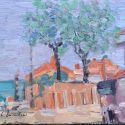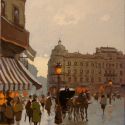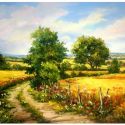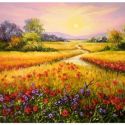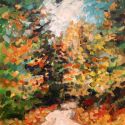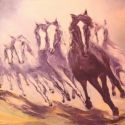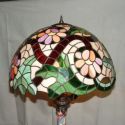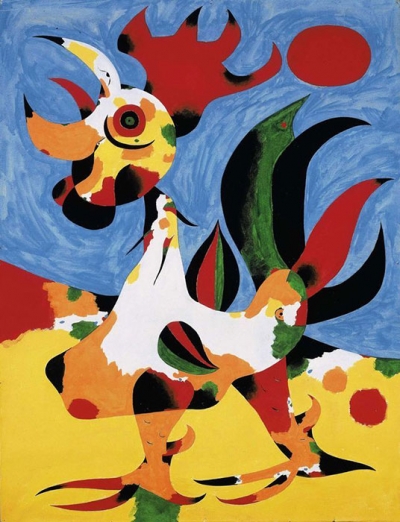
In 1907, Mirò entered the School of Fine Arts in Barcelona. There, he took lessons from an artist named José Pascó. Though Mirò was already comfortable with techniques of coloring, he was unsure of himself as a draftsman. Pascó helped Mirò develop a more sophisticated drawing style, urging Mirò to draw using a sense of touch. In addition, Pascó helped spark Mirò’s love for sculpture. Mirò’s career at the School of Fine Arts, however, was short-lived. His parents, artists themselves, disapproved of their son’s choice of profession, and Mirò withdrew from the school in 1910 to become a clerk. Following a mental breakdown two years later, Mirò enrolled at Barcelona’s Academy Galí with his parents’ blessing to resume studying art. At the Academy Galí, Mirò received a better-rounded education and acquired a penchant for poetry.
In 1915, Mirò left the Academy Galí and began painting by himself. At this time, he became influenced mainly by French Fauvism and Central European Expressionism movements. These influences are apparent in many of Mirò’s 1915-1916 landscapes, characterized by an arbitrary use of color and much distortion.
In 1917, Mirò met José Dalmau, an art dealer in Barcelona who introduced the young artist to several Cubist paintings. Mirò’s artwork changed considerably after this meeting, acquiring more vivid and personal coloring. Also around this time, Mirò began to heavily experiment with portraiture. Several portraits, including Portrait of E.C. Ricart and Portrait of a Goldsmith, show an obvious influence from post-Impressionist artists like Paul Cézanne and Vincent van Gogh.
In 1918, Mirò held his first one-man show in Barcelona, featuring 64 paintings and several other sketches. Dalmau extensively promoted Mirò’s first showing, which garnered considerable local attention. Dalmau also encouraged Mirò to go to Paris to join the art scene there. Excited about the prospect of meeting fellow Catalan Pablo Picasso, Mirò traveled to Paris on March 3, 1919. Although he stayed in Paris for a few months and enjoyed meeting with Picasso, Mirò soon became disenchanted with the Impressionist and Fauvist movements. Preferring the ambiance of Barcelona, Mirò returned to Spain in spring of that year.
For a short time, Mirò played with realistic still-life painting and attempted to sharpen his technique by drawing commonplace objects. In 1923, however, Mirò turned more toward abstraction, as is evident in the bestiary painting, The Tilled Field, and the poetic work, Catalan Landscape (The Hunter). During this time Mirò befriended many Dada poets, though André Breton and the Surrealists also began to influence Mirò’s artwork. Breton would later call Mirò "the most ‘Surrealist’ of us all." Mirò admired the liberty advocated by the Surrealists, and he began experimenting with the Surrealist technique of automatic painting in which recognizable objects rarely appear. In the mid- to late-twenties, Mirò began painting fairly abstract and freely organized works, such as Le corps de ma brune… and The Candle. Mirò’s exposure to poetry at the Academy Galí also became evident in these works, as he liberally used written words as an integral element of his painting. Altogether, these works gained Mirò much recognition, and his second one-man show in Paris was well received by the most influential art critics.
In 1928, Mirò visited Holland, where he became excited about the paintings of great Dutch artists and painted a few very calculated paintings in the same manner. Soon afterwards, though, Mirò switched gears and stopped giving his works large amounts of preparatory thought. He began to create a number of infantile collages and quickly executed paintings that frequently featured ferocious and swirling forms inspired by dreams and hallucinations. In addition to painting works on canvas, Mirò also started to paint ballet sets with Max Ernst for a short time.
Amidst this extremely productive period of Mirò’s career, in 1929 the artist married his cousin, Pilar Juncosa, and the couple became parents in 1931 to a daughter named Marie Dolores. Two years later, Mirò reached his artistic apex and painted several large, abstract compositions, such as Painting, in which Mirò based the horned shapes on machinery parts. It was also at this time that Mirò began to paint in the childlike and dreamy style for which he is most recognized. He worked in an almost automatic fashion during this period, creating strangely precise works using a casual artistic intuition. Mirò adeptly played with bright color tones, and he used rich blacks in a particularly penetrating manner. Besides numerous paintings, Mirò also did much collage work. In a series of works entitled Collage, Mirò combined paint with postcards, engravings, photographs and odd objects like string, felt and metal. During this period, Mirò also began to develop an interest in texture, and he began painting on sandpaper and various rough surfaces in a very playful way.
In the late 1930s, when the Spanish Civil War broke out, Mirò was living in Paris. He remained there during this conflict, virtually cut off from contact with his homeland. Though Mirò claimed a lack of interest in political matters, he was nonetheless worried for his country’s poverty and suffering. Consequently, his paintings expressed this melancholy with dark, lurid colors and frightening images. In 1937, Mirò painted Still Life with Old Shoe in direct response to the war. He also painted an anti-Franco poster entitled Help Spain.
In 1938, Mirò returned to the art of the portrait, and he created an important series of abstract portraits before World War II. Many of these abstract portraits have a celestial aura, most notably Mirò’s self-portrait, in which he depicts himself ascending toward the heavens. In these works, Mirò frequently portrays eyes as starry pinwheels and often uses shapes of the sunburst and starfish. At the same time as he created this series of abstract portraits, Mirò also perfected his poetry paintings. Possessing a deep love for poetry, which began in Mirò’s student days, the artist once commented that paintings "make no distinction between painting and poetry." In his poetry paintings, Mirò would write poetic phrases on his canvasses. One of the most famous examples of Mirò’s poetry-paintings is his Painting-Poem of 1938, which features the French expression "une étoile caresse le sein d’une négresse" ("a star caresses the breast of a black woman") atop a vast black background.
In 1942, Mirò explored his fascination with texture and started to work with ceramics. At first, the pottery shapes were unconventional and non-utilitarian, though the pieces eventually evolved into traditional sculptures of heads and plaques. Mirò’s ceramics were huge, some up to 12 feet in height. For some time, Mirò concentrated upon sculpture and did relatively little painting. In 1947, however, Mirò received a commission to paint a mural for the Terrace Plaza Hotel in Cincinnati and spent eight months there completing the work.
From the 1950s onward, Mirò spent most of his efforts on further exploring new media. In the late fifties, he began working on illustrations and woodcuts for Paul Eluard’s book of poems, A Toute Épreuve. Besides this project, Mirò also turned out over 200 sculptures in a few years. This period of experimentation was briefly interrupted in 1960, when Mirò returned to the United States to paint a mural for Harvard University. During the later stage of his career, Mirò’s earlier works were showcased around the world in huge exhibitions at the most respected museums. Also around this time, Mirò received multiple awards, including the Guggenheim International Award. In 1975, the Joàn Mirò Foundation/Center for the Study of Contemporary Art opened in Barcelona in dedication to the artist. Joàn Mirò died in Palma de Mallorca.
With an intense use of color, fanciful shape and a wide array of media, Joàn Mirò created a body of provocative work overflowing with imagination, intense beauty, and elegance. Following an early fascination with portraiture (which reemerged later in his career), Mirò soon focused on works that tended more toward abstraction and Surrealism. After developing this signature style, Mirò began to incorporate his love of poetry into his works, featuring words as prominent parts of his paintings. After becoming a master of the canvas, Mirò turned his attention to other media, such as ceramics, sculpture, and woodcutting. With a voluminous body of work spanning such diverse periods of artistic evolution, Mirò left an artistic legacy that will take decades to digest but only seconds to savo



